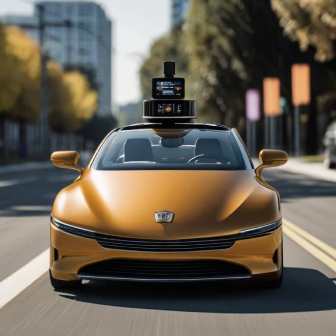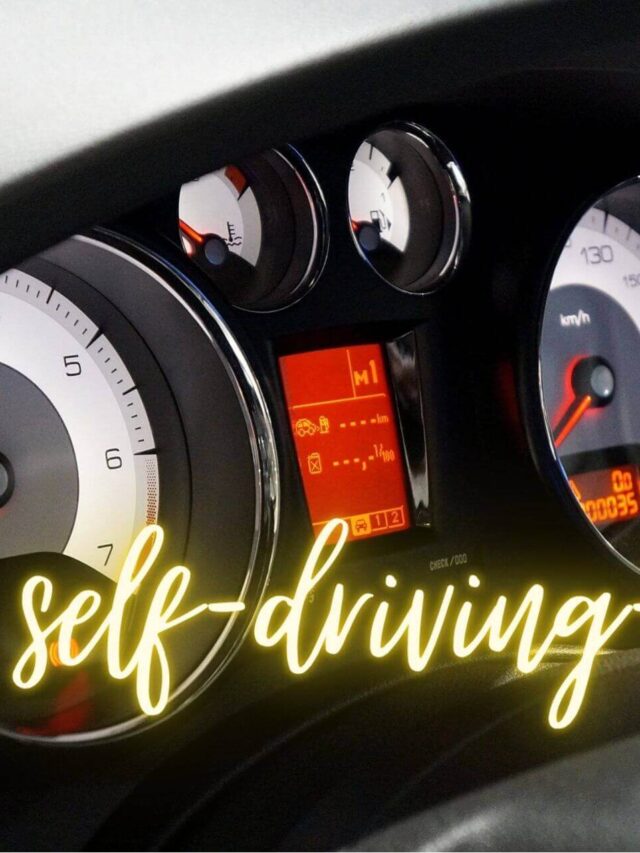AI Driverless Cars: 6 Miracle Drives to Tomorrow
Embracing the future: AI driverless cars
- 0.1 Embracing the future: AI driverless cars
- 0.2 What’s the technology behind Cars with Autopilot?
- 0.3 Cars with autopilot could re-shape our cities
- 0.4 Self-driving cars pros and cons
- 0.5 Will driverless cars reduce traffic?
- 0.6 How many accidents with self-driving cars?
- 0.7 What data is collected by self-driving cars?
- 0.8 Which field of AI is used for self-driving cars?
- 0.9 How are self autonomous cars controlled?
- 0.10 Do self-driving cars help the environment?
- 0.11 What is the biggest issue with self-driving cars?
- 0.12 Why are people afraid of self-driving cars?
- 0.13 Why driverless cars should not be allowed in India?
- 0.14 When will autonomous vehicles become reality?
- 1 Frequently Asked Questions(FAQs)
- 1.1 FAQ1: How Self-Driving Cars are Changing the Game?
- 1.2 FAQ2: How would self-driving cars work?
- 1.3 FAQ3: How safe are self-driving or autonomous driving cars?
- 1.4 FAQ4: When will self-driving cars be available to consumers?
- 1.5 FAQ5: Do you actually think self-driving cars would reduce traffic?
- 1.6 FAQ6: Can self-driving cars reduce accidents?
- 1.7 FAQ7: Can self-driving cars reduce pollution?
- 1.8 FAQ8: Can self-driving cars speed?
- 1.9 FAQ9: Can self-driving cars be hacked?
- 1.10 FAQ10: Why self-driving cars are the future?
- 1.11 FAQ11: Are self-driving cars artificial intelligence?
- 1.12 FAQ12: Are self-driving cars electric?
- 1.13 FAQ13: Are self-driving cars available to the public?
- 1.14 FAQ14: Are self-driving cars dangerous?
- 1.15 FAQ15: What do you think of self-driving cars?
- 1.16
AI driverless cars and autonomous transportation is a rapidly developing field. It involves the use of artificial intelligence, machine learning, and other advanced technologies to enable vehicles to operate without human input.
These vehicles use a combination of sensors, cameras, and mapping technology to navigate and make decisions on the road.
The goal is to improve safety, reduce traffic congestion, and make transportation more efficient.
There are several companies and organizations currently working on self-driving car technology, including Tesla, Google’s Waymo, and Uber.
What’s the technology behind Cars with Autopilot?
Self-driving cars, also known as autonomous vehicles, use a combination of advanced technologies to navigate and make decisions on the road without human input. How cars with autopilot are Changing the Game is due to technologies include:
- Sensor Fusion: ai driverless cars use a combination of sensors, such as lidar, radar, and cameras, to gather data about the vehicle’s surroundings. This information is then combined, or “fused,” to create a comprehensive understanding of the vehicle’s environment.
- Advanced Navigation: ai driverless cars use high-definition maps and GPS to navigate and understand their surroundings. They are also able to recognize and respond to traffic signals, road signs, and other landmarks.
- Artificial Intelligence and Machine Learning: cars with autopilot use AI and machine learning to process the data gathered by sensors and make decisions on the road. For example, the vehicle may use AI to detect and respond to other vehicles, pedestrians, and obstacles on the road.
- Automatic Emergency Braking: cars with autopilot are equipped with sensors that can detect potential collisions and automatically apply the brakes to avoid or mitigate the impact of a crash.
- Automatic Steering and Acceleration: ai driverless cars are equipped with advanced control systems that can automatically steer the vehicle, accelerate and decelerate, and maintain a safe distance from other vehicles.
- Lane Keeping and Adaptive Cruise Control: Autonomous vehicles are able to detect and stay within their lane, and also maintain a safe distance from the vehicle in front.
- Remote Monitoring and Control: Some autonomous vehicles can be monitored and controlled remotely, allowing fleet operators or service providers to remotely manage and maintain the vehicles.
- Communication technology: Autonomous vehicles use wireless communication technologies like V2V (vehicle-to-vehicle) and V2X (vehicle-to-infrastructure) to share information with other vehicles and road infrastructure. This allows vehicles to coordinate their movements, avoid collisions, and improve traffic flow.
As technology is advancing rapidly, more features are being added to the autonomous vehicles.
Cars with autopilot could re-shape our cities
Autonomous vehicles have the potential to greatly change our lives and reshape our cities in several ways. Some of the ways they could change our lives include:
- Improved safety: AI driverless cars have the potential to greatly reduce the number of accidents caused by human error, which is responsible for the vast majority of traffic accidents. This could save thousands of lives and prevent many injuries each year.
- Increased mobility: AI driverless cars could make transportation more efficient and accessible, particularly for those who are unable to drive, such as the elderly and disabled. This could lead to greater mobility and independence for these groups.
- Reduced traffic congestion: AI driverless cars could help reduce traffic congestion by improving traffic flow and reducing the need for human drivers. This could lead to shorter commutes, fewer traffic jams, and less time spent stuck in traffic.
- Increased productivity: AI driverless cars could free up people’s time during their daily commute, enabling them to work, read, or relax while the vehicle is in motion. This could lead to increased productivity and a better work-life balance for many people.
- Re-shaped cities: AI driverless cars could have a major impact on urban planning and the design of cities. With the reduced need for human drivers, cities could be designed with fewer parking lots and garages, and more green spaces and walk able areas. This could lead to more livable and sustainable cities.
- Economic impact: AI driverless cars could have a significant impact on the economy, including the creation of new jobs and the displacement of existing ones. They could also change the way people and goods are transported, affecting industries such as logistics and trucking.
However, it’s worth noting that the implementation of AI driverless cars in large scale and its impact will also depend on how society chooses to utilize.
Self-driving cars pros and cons
Self-driving cars have the potential to have both positive and negative effects on society.
Positive effects:
Improved safety: Cars with autopilot have the potential to greatly reduce the number of accidents caused by human error, which is responsible for the vast majority of traffic accidents. This could save thousands of lives and prevent many injuries each year.
Increased mobility: Cars with autopilot could make transportation more efficient and accessible, particularly for those who are unable to drive, such as the elderly and disabled. This could lead to greater mobility and independence for these groups.
Reduced traffic congestion: Cars with autopilot could help reduce traffic congestion by improving traffic flow and reducing the need for human drivers. This could lead to shorter commutes, fewer traffic jams, and less time spent stuck in traffic.
Increased productivity: Cars with autopilot could free up people’s time during their daily commute, enabling them to work, read, or relax while the vehicle is in motion. This could lead to increased productivity and a better work-life balance for many people.
Re-shaped cities: Cars with autopilot could have a major impact on urban planning and the design of cities. With the reduced need for human drivers, cities could be designed with fewer parking lots and garages, and more green spaces and walkable areas. This could lead to more livable and sustainable cities.
Negative effects of Cars with autopilot include:
Job loss: Cars with autopilot could lead to job loss for human drivers, particularly in the trucking and transportation industries. This could have a significant economic impact on communities that rely on these jobs.
Privacy concerns: Cars with autopilot could raise privacy concerns as they rely on a large amount of data from sensors and cameras. This data could be used for surveillance and tracking, which could raise concerns about civil liberties.
Technical challenges: Cars with autopilot rely on complex technology that is still being developed and refined. If the technology is not reliable or fails, it could lead to accidents or other problems.
Ethical concerns: Cars with autopilot raise ethical concerns about decision-making in cases where the car has to make a choice between two or more negative outcomes, such as sacrificing the lives of its passengers to save the lives of pedestrians.
Societal changes: AI driverless cars could change the way people use cars, potentially reducing the number of cars on the road and changing the way people move through cities. This could have a significant impact on car ownership, car culture, and the way cities are planned and built.
Cyber security concerns: AI driverless cars cars rely on large amounts of data and connectivity, they could be vulnerable to cyber-attacks which could compromise the safety of the passengers and other road users.
Cost: The cost of the technology and its maintenance can be high, which may make it difficult for some people to afford.
Socio-economic impact: The adoption of ai driverless cars could have a disproportionate impact on certain groups of people, such as low-income families and people in rural areas who may not have access to the technology.
Will driverless cars reduce traffic?
Self-driving cars have the potential to reduce traffic by improving traffic flow and reducing the need for human drivers. This could lead to shorter commutes, fewer traffic jams, and less time spent stuck in traffic.
Self-driving cars can communicate with other cars and infrastructure on the road, such as traffic lights and signs, which could allow them to optimize their speed and route to avoid congestion. This can also help to reduce traffic by making the traffic flow more efficient and reducing the number of accidents on the road.
Additionally, self-driving cars could lead to an increase in carpooling and shared ride services, which could reduce the number of cars on the road. This could help to reduce traffic and parking congestion in cities.
However, it’s worth noting that the effects of self-driving cars on traffic will likely depend on the rate of adoption, the technology’s reliability and safety, and the infrastructure and regulations in place these tell How Self-Driving Cars are Changing the Game.
It’s also worth noting that the effects will depend on how the self-driving cars are used. For example, if they are primarily used for ride-hailing services and personal use, traffic may actually increase as people use them for short trips that would have otherwise been done by walking or biking. On the other hand, if they are primarily used for shared-ride services and public transportation, traffic may decrease as more people switch to the autonomous vehicles for their transportation needs.
How many accidents with self-driving cars?
As of my knowledge cutoff in 2021, there have been a number of accidents involving self-driving cars, although the total number is still relatively small compared to the overall number of accidents involving human-driven cars.
One of the most high-profile accidents involving a self-driving car occurred in 2018, when a pedestrian was struck and killed by a self-driving car operated by Uber in Tempe, Arizona. The incident led to Uber suspending its self-driving car program and raising questions about the safety of autonomous vehicles.
In 2019, another accident involving a self-driving car occurred in Arizona, when a pedestrian was struck and killed by a self-driving car operated by Waymo, a subsidiary of Alphabet (Google).
A report by the National Transportation Safety Board in 2020, shows that Tesla’s Autopilot was engaged at the time of a fatal crash in California, in 2018.
It’s worth noting that these accidents have occurred during the testing phase of the technology, and as self-driving cars are still being developed and refined, the number of accidents involving them is likely to change over time. Additionally, It’s worth mentioning that the causes of accidents involving self-driving cars could be varied, some could be caused by human error and others could be caused by technical issues.
Overall, it’s important to note that the overall safety record of self-driving cars is still being established and will likely improve over time as the technology continues to be developed and tested.
What data is collected by self-driving cars?
Self-driving cars collect a wide range of data from various sensors, cameras, and other systems. This data is used to understand the car’s environment, including the location of other vehicles, pedestrians, and objects, as well as the road conditions and traffic signals.
Examples of data that may be collected by self-driving cars include:
LiDAR, radar and cameras data, which provide a 3D representation of the car’s surroundings.
GPS data, which provides information on the car’s location and the location of other vehicles.
Sensor data, such as wheel speed, yaw rate, and acceleration, which provide information on the car’s movement.
Data from traffic management systems, such as traffic lights and road signs, which provide information on the traffic conditions.
Data from other connected vehicles, which can provide information on traffic patterns and potential hazards.
It’s important to note that the data collected by self-driving cars is usually used to improve the car’s ability to navigate and make decisions and it’s deleted after the use.
Which field of AI is used for self-driving cars?
Self-driving cars make use of several branches of AI, including computer vision, machine learning, and control systems.
Computer vision is used to process the data collected by the cameras and other sensors on the car, allowing the car to identify and understand its environment. This includes recognizing other vehicles, pedestrians, traffic signals, and other objects.
Machine learning is used to train the car’s decision-making system, allowing it to make safe and efficient driving decisions. The car’s decision-making system is trained on large datasets of driving scenarios, allowing it to learn how to respond to different situations.
Control systems are used to control the car’s movement, including steering, braking, and acceleration. These systems use the data from the sensors and the decision-making system to control the car’s movement in a safe and efficient manner.
Additionally, self-driving cars also make use of other AI techniques such as path planning, localization, sensor fusion and natural language processing for communication and human-machine interaction.
How are self autonomous cars controlled?
Self-autonomous cars are controlled through a combination of hardware and software systems.
The hardware systems include the sensors, cameras, and other devices that are used to gather data about the car’s environment. This includes lidar, radar, cameras, GPS, and other sensors that are used to detect and track other vehicles, pedestrians, and objects.
The software systems include the decision-making system, control system, and other algorithms that are used to interpret and respond to the data gathered by the hardware systems.
The decision-making system is responsible for determining the car’s actions based on the data it receives. This system uses machine learning algorithms to analyze the data and make predictions about the car’s environment. It also uses rule-based systems, pre-programmed scenarios and safety checks to ensure that the car’s actions are safe and efficient.
The control system is responsible for controlling the car’s movement. This includes controlling the car’s braking, acceleration, and steering based on the decisions made by the decision-making system. It communicates with the car’s power train and other mechanical systems to execute the desired actions.
Overall, the car’s hardware and software systems work together to ensure that the car can navigate and respond to its environment in a safe and efficient manner.
Do self-driving cars help the environment?
Self-driving cars have the potential to help the environment in several ways. Here are a few examples:
- Improved energy efficiency: Self-driving cars can be programmed to drive in a more fuel-efficient manner, such as maintaining a consistent speed, braking more gently and avoid sudden accelerations. This could lead to a reduction in fuel consumption and emissions.
- Reduced traffic congestion: Self-driving cars can communicate with each other and with traffic management systems, which could help to reduce traffic congestion. This could lead to fewer cars on the road and less time spent idling in traffic, which would in turn reduce emissions and fuel consumption.
- Increased car-sharing: Self-driving cars have the potential to make car-sharing more convenient and efficient. This could reduce the number of cars on the road and decrease the need for individual car ownership.
- Increased safety: Self-driving cars have the potential to reduce the number of accidents and injuries on the road. This would in turn reduce the need for emergency services, which would lead to a reduction in emissions from emergency vehicles.
It’s worth noting that the extent to which self-driving cars will help the environment will depend on how they are implemented and how they are used. For example, if self-driving cars are primarily used for individual car ownership, it may not lead to significant environmental benefits.
What is the biggest issue with self-driving cars?
One of the biggest issues with self-driving cars is safety. Self-driving cars rely on a complex system of sensors and software to navigate and make decisions, and any failure or malfunction in this system could lead to accidents or other safety issues.
Ensuring the safety and reliability of these systems is a major challenge, and it is critical to thoroughly test and validate these systems before they are put into use.
Another major issue with self-driving cars is cybersecurity. Self-driving cars are vulnerable to hacking and other cyberattacks, which could compromise the car’s systems and put passengers and other road users at risk. Ensuring the security and integrity of the car’s systems is crucial to prevent these types of incidents.
Additionally, the legal and ethical issues surrounding self-driving cars are also a concern. This includes issues such as liability in case of accidents and determining who is responsible when something goes wrong.
The lack of standardization and regulation of self-driving cars is also a concern. This could lead to different levels of safety and performance between cars from different manufacturers, which would make it difficult to ensure the safety of all road users.
Lastly, the cost of self-driving cars, as well as the cost of the technology required to make them, is a major issue. These costs are currently high and could limit the adoption of self-driving cars, especially for those who can’t afford it.
Why are people afraid of self-driving cars?
There are several reasons why people may be afraid of self-driving cars:
- Lack of understanding: Some people may not fully understand how self-driving cars work, and may be afraid of the technology because they don’t know what to expect.
- Safety concerns: Self-driving cars rely on complex systems of sensors and software to navigate and make decisions, and there is a concern that these systems may not always work as intended. This could lead to accidents or other safety issues.
- Job loss concerns: Self-driving cars could potentially lead to job loss for people who work in the transportation industry, such as truck and taxi drivers.
- Cyber security concerns: Self-driving cars are vulnerable to hacking and other cyberattacks, which could compromise the car’s systems and put passengers and other road users at risk.
- Ethical concerns: Self-driving cars raise ethical questions, such as how to program the car to make decisions in case of an accident and who is responsible when something goes wrong.
- Loss of control: Some people may feel uncomfortable giving up control of the car to a computer, which may cause them to feel uneasy.
- Fear of change: Some people may be resistant to change and may be afraid of self-driving cars because they represent a major shift in the way we think about transportation.
Overall, the fear of self-driving cars is often based on a lack of understanding and uncertainty about the technology. It’s important for people to be informed and educated about self-driving cars, so that they can make informed decisions about the technology.
Why driverless cars should not be allowed in India?
There are a number of reasons why self-driving cars may not be well-suited for India at this time:
- Infrastructure: India’s roads and infrastructure are not yet fully equipped to handle self-driving cars. Many Indian roads are poorly maintained and lack clear markings, making it difficult for self-driving cars to navigate. Additionally, many areas of India lack basic infrastructure such as traffic signals, which would be necessary for self-driving cars to operate safely.
- Traffic laws: India’s traffic laws are not yet fully adapted to self-driving cars. This can create confusion for the cars and for human drivers, making it difficult to ensure safety on the roads.
- Cost: Self-driving cars are still relatively expensive and may be out of reach for many Indians. This could make it difficult for the technology to be adopted on a large scale.
- Safety concerns: As discussed previously, the safety record of self-driving cars is still being established, and there are still concerns about the technology’s reliability and ability to handle complex driving situations.
- Cyber security concerns: Self-driving cars rely on a large amount of data and connectivity, they could be vulnerable to cyber-attacks which could compromise the safety of the passengers and other road users, India is still struggling with Cybersecurity concerns, this could be an added issue.
- Socio-economic impact: The adoption of self-driving cars could have a disproportionate impact on certain groups of people, such as low-income families and people in rural areas who may not have access to the technology.
All that being said, it’s worth noting that self-driving cars are still a relatively new technology, and it’s possible that the situation in India could change as the technology develops and infrastructure and regulations are adapted to accommodate them.
When will autonomous vehicles become reality?
It is difficult to predict exactly when autonomous vehicles will become a reality and be widely adopted. The development and deployment of autonomous vehicles is a complex process that involves a number of technical, regulatory, and societal challenges.
There are already some autonomous vehicles on the road today, such as Tesla’s Autopilot and Waymo’s self-driving cars. However, these vehicles are still considered semi-autonomous and require a human driver to be ready to take over in case of an emergency.
Fully autonomous vehicles, which do not require a human driver, are still in the testing phase. Some companies and organizations, such as Waymo, have announced plans to deploy fully autonomous vehicles for ride-hailing and other commercial purposes in the next few years. However, these vehicles are still facing some technical and regulatory challenges before they can be deployed on a large scale.
Regulations are also a major hurdle for the widespread deployment of autonomous vehicles, as governments must develop safety standards and regulations for autonomous vehicles. This process can take time and may vary depending on the country.
In summary, it is likely that autonomous vehicles will become a reality in the near future, but it may take several more years before they are widely adopted and deployed on a large scale.
Self-driving and autonomous transportation have the potential to bring significant benefits in terms of safety, efficiency, and accessibility. However, there are also challenges that need to be addressed, such as ensuring the reliability and safety of the technology, addressing ethical and legal issues, and ensuring the integration of self-driving cars into existing infrastructure and traffic flow.
It is important for continued research and development to be done in order to address these challenges and to ensure that the technology is safe and reliable before it is widely implemented.
In addition, it is important to have standardization and regulation for self-driving cars to ensure that all cars meet the same safety and performance standards. This would make it easier to ensure the safety of all road users.
It is also important to educate the public about self-driving cars so that people can make informed decisions about the technology. This includes providing information about how the technology works, its benefits and limitations, and addressing any concerns people may have.
Overall, self-driving and autonomous transportation have the potential to bring significant benefits, but it is important to approach the technology with caution and to address the challenges that need to be addressed to ensure the safety and reliability of the technology.
Also Read: The Future of Reality: How Virtual Reality is Changing the World
Also Read: Microservice we divide a big application into small
Also Read: The Art and Science of Photography
Frequently Asked Questions(FAQs)
FAQ1: How Self-Driving Cars are Changing the Game?
Self-driving cars will change your life by:
- Convenience: They’ll make commuting and travel easier, as you can relax or work during your ride instead of driving.
- Safety: With advanced sensors and AI, self-driving cars aim to reduce accidents caused by human error, potentially making the roads safer for everyone.
FAQ2: How would self-driving cars work?
Self-driving cars work using a combination of sensors, cameras, and AI software. These sensors gather information about the car’s surroundings, and the AI processes this data to make driving decisions like accelerating, braking, and steering. It’s like having a smart computer as the driver, ensuring the car can navigate safely without human intervention.
FAQ3: How safe are self-driving or autonomous driving cars?
Self-driving cars are designed with safety in mind, using advanced sensors and AI to navigate and avoid accidents. However, their safety depends on technology development, regulation, and real-world testing. As technology improves and regulations become more robust, self-driving cars have the potential to be safer than human-driven cars in the future.
FAQ4: When will self-driving cars be available to consumers?
The availability of self-driving cars to consumers varies by location and company. Some self-driving features are already in certain vehicles, but fully autonomous cars for general use may take several years to become widely accessible as technology and regulations continue to develop. It’s a gradual process, so it’s essential to stay updated on local availability and advancements from car manufacturers.
FAQ5: Do you actually think self-driving cars would reduce traffic?
Self-driving cars have the potential to reduce traffic by driving more efficiently and coordinating with each other. They can improve traffic flow and reduce congestion, but it depends on how well they are integrated into existing transportation systems and how many self-driving cars are on the road. It’s a complex issue, and the extent of traffic reduction will vary in different locations and scenarios.
FAQ6: Can self-driving cars reduce accidents?
Yes, self-driving cars have the potential to reduce accidents. They use advanced sensors and AI to make split-second decisions, which can be safer than human drivers who may make errors due to distractions or fatigue. However, it’s essential to thoroughly test and refine the technology to ensure its safety and effectiveness.
FAQ7: Can self-driving cars reduce pollution?
Yes, self-driving cars have the potential to reduce pollution. They can drive more efficiently, optimize routes, and use electric power, which can lower emissions compared to traditional cars. However, the extent of pollution reduction also depends on the adoption of clean energy sources and the overall transportation system.
FAQ8: Can self-driving cars speed?
Self-driving cars can operate at different speeds, just like traditional cars. Their speed depends on the rules and limits set by the human or AI driver controlling them. They can adjust their speed to match traffic conditions, road signs, and safety requirements.
FAQ9: Can self-driving cars be hacked?
Yes, self-driving cars can be vulnerable to hacking, just like any computerized system. It’s crucial for manufacturers to implement strong cybersecurity measures to protect these vehicles from potential threats and ensure the safety of passengers. While hacking risks exist, ongoing security efforts are focused on minimizing these vulnerabilities.
FAQ10: Why self-driving cars are the future?
Self-driving cars are the future because they have the potential to make transportation safer, more convenient, and more efficient. They can reduce accidents caused by human error, ease traffic congestion, and provide mobility for those who can’t drive. While there are challenges to overcome, the promise of a safer and more accessible transportation system makes self-driving cars an exciting prospect for the future.
FAQ11: Are self-driving cars artificial intelligence?
Yes, self-driving cars use artificial intelligence (AI) to operate. They rely on AI algorithms to process data from sensors and make driving decisions, such as steering, braking, and accelerating, without human intervention. AI is a fundamental technology that enables self-driving cars to function.
FAQ12: Are self-driving cars electric?
Self-driving cars can be electric, but they can also use traditional gasoline or hybrid power sources. The choice of the power source depends on the design and goals of the vehicle. Electric self-driving cars are becoming more popular due to their potential for reducing emissions and their compatibility with sustainable energy sources.
FAQ13: Are self-driving cars available to the public?
Self-driving cars are becoming available to the public, but the availability varies by location and company. Some autonomous features, like adaptive cruise control and lane-keeping assist, are already in many new cars, while fully autonomous self-driving taxis and personal vehicles are being tested and gradually introduced in certain areas. However, widespread availability may take more time as technology and regulations continue to evolve.
FAQ14: Are self-driving cars dangerous?
Self-driving cars are designed with safety in mind and have the potential to reduce accidents caused by human errors like distractions or fatigue. However, like any technology, there are risks and challenges to overcome. Ongoing testing, development, and strong safety regulations are essential to minimize these risks and make self-driving cars as safe as possible.
FAQ15: What do you think of self-driving cars?
Self-driving cars have the potential to improve transportation safety and efficiency, but their success depends on continued development and addressing various challenges, including regulatory and ethical considerations. People’s opinions about self-driving cars may vary based on their experiences and perspectives.








































2 thoughts on “AI Driverless Cars: 6 Miracle Drives to Tomorrow”